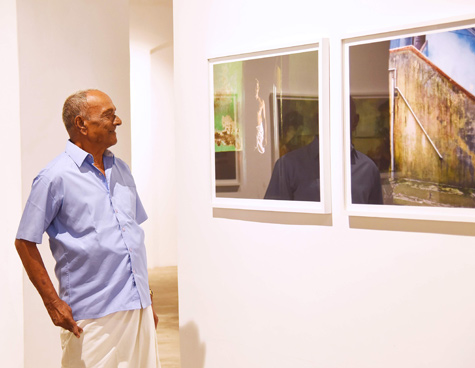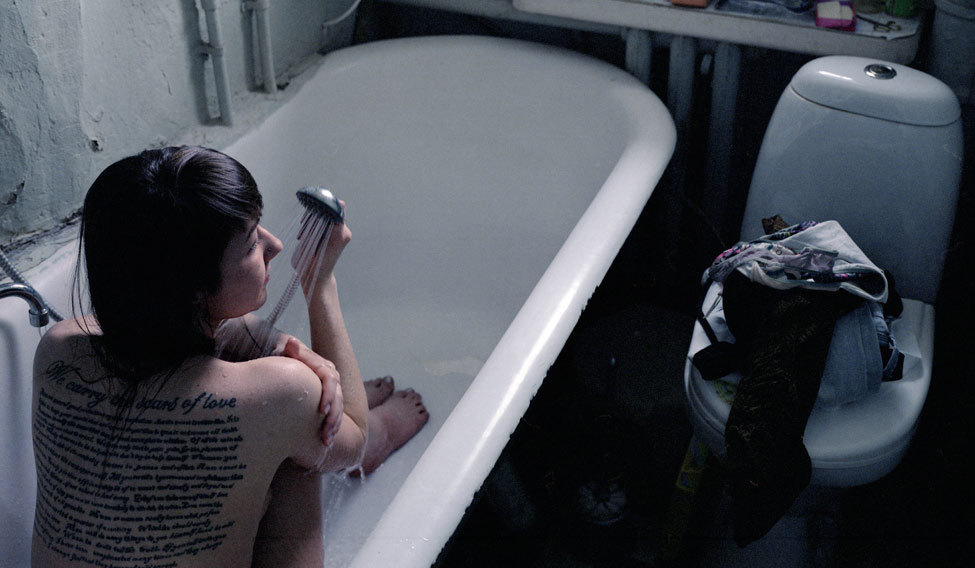A broad smile dawned on the wrinkled, but graceful face of Abdul Rahman (Andamu), 80, when he saw himself in a portrait at the preview of Living Climate—A Tale of Three Cities art photography exhibition at Uru Art Harbour, Kochi. Four years ago, when he was being photographed at his house in Mattancherry, Kochi, by illustrious international photographer Andre Leutzen, neither did he know who Leutzen was, nor had he imagined himself as a poster-man for an art exhibition.
“I was coming out of toilet when I saw the foreigner (Leutzen) with a camera in my house,” Rahman recollects. “He asked me to stand in the position when I was just outside the toilet, and took the picture.” Rahman was brought to Uru by his son C.A. Siraj, a decoration worker, who saw his father in the promotional posters of the photo-art exhibition that started on January 17 and will continue till February 28.
In Living Climate... Leutzen explores how climatic conditions influence the lives of people, like Rahman, in different cultures. The exhibition features his photo-projects themed around public-private living spaces. All the photographs were taken during 2014 to 2017 in three different cities under different weather conditions—Kochi in southern India during the monsoon (Inside Out Kochi), Arkhangelsk of north-western Russia during the biting winter with temperatures as low as -40 degrees Celsius (Zhilli Byli) and Khartoum of Sudan in extreme summer with temperatures as high as 45 degrees Celsius (Khartoum).
Leutzen learnt visual communication at the Academy of Fine Arts, Hamburg, and at the International Centre of Photography in New York. His works have been featured in many international publications and exhibitions like the New York Photo Festival. He has been teaching photography and conducting workshops in different parts of the world for past two decades.
 Andre Leutzen | Vipin Das P.
Andre Leutzen | Vipin Das P.
During his initial days as an art student in Hamburg, he wanted to become a filmmaker. “But, it is always a team behind a film,” says Leutzen. “As young film students, we also had a lot of arguments. This was a bit annoying and I don't like working in teams. That is why I decided to step out and pursue photography so that I can work on my own.”
He didn't, however, completely ditch the idea of filmmaking—he has developed his exhibitions by sequencing single images. “These are not major single images that you see here. This is more or less like a film,” he says. “It is documentary photography. But, by sequencing and trying to bring connections, it is fiction, too. It twists the interpretation and reception a few degrees for the viewers and gives them new meanings.”
Leutzen started exploring the living space of people, through his camera, first in Hanoi, Vietnam. “While walking through Hanoi, I saw that specially at night, people were coming outside,” he says. “During the day, there were not many on the streets since it is too hot. People start to come out at night and use public spaces actually as their living rooms. These are small houses and lot of families have generations living under one roof. So, in the night they open up the doors and sit outside, eat outside.”
In Hanoi, he observed boundaries disappearing, and private living spaces coexisting with public spaces. Whereas in Khartoum, Arkhangelsk and Kochi he saw people being forced to restrict themselves to their indoors due to the climate. “I continued with this project in Russia. But there I saw something extremely opposite,” he says. “There you are not going outside with your family, but rather prefer to stay inside. In Khartoum also, people don't go out since it is hot. Sometimes they go sit along the banks of the Nile river. But that is not really a public life.” In all the three cities, he sought the help of translators or assistants to communicate with the local people.
He came to Kochi as part of the Pepper House Residency project of Kochi-Muziris Biennale 2014. “I was thinking what can I do (in Kochi). I was reading about the monsoon season and I thought this might can be turned into something,” he says. Acclaimed Indian multimedia artist and activist Riyas Komu in his critic note on Leutzen's work on Kochi says, “Inside Out Kochi eschews sentimentality in favour of raw emotion and lets the story tell itself forcing the reader to 'look' beyond the impeccably composed plot and themes to the discordant riches that typifies post colonial India.”
The note continues saying, “But, Leutzen's images cut deeper into emotional life and stretch farther back into the history of the land—almost concealing a bitter cautionary tale with images that not only capture the architectural residues but also the residue of a social and cultural past which Kochi's current inhabitants have been unable to overcome. A longing to belong today is seeded into these photographs.”
“Leutzen's subjects do not perform for the camera,” says Leonhard Emmerling, director programmes, South Asia, Goethe Institute, New Delhi. “It is like they forgot about the camera. He captures them in a moment where they are not even aware any more that there is a camera.”
For his photographic projects, Leutzen captures pictures on analogue. He uses a 6x7 medium format, with a Mamiya 7II. “When I started photography there was only analog photography. But, continuing with this is something, its a different quality,” says Leutzen. “And, it is a different process of taking pictures. Here you have just 10-frames analogue which you cannot see. You have to see through the finder and you have to decide. So, you have to trust yourself. In digital photography, you are not trusting yourself. Because the technology gives you an advantage to look at the image again and again.”
 Abdul Rahman—who got featured in one of the photographs of Andre Leutzen | Vipin Das P.
Abdul Rahman—who got featured in one of the photographs of Andre Leutzen | Vipin Das P.
He is not completely reluctant to use digital photography; during his workshop sessions he uses digital. But he is against the idea that everyone who carries a digital camera or smartphone is a photographer.
“These may be visual notes we are taking. These are not really pictures, although the quality of smartphone cameras are getting better and better,” he says. “But, that is not photography.”
“Photography is a process of working with tools like camera to develop your own visual language. It is a process of getting deeper and deeper into a subject,” says Leutzen.
Even when doing such an exploration, there isn't any sort of voyeurism in his works, points out Riyas. Leutzen says that he always took permission from his subjects to photograph. But for that he had to overcome the language barrier in all the three cities he explored in Living Climate....
“I explain what I do and I would introduce myself through the person—an assistant or translator— to help in making contact with people,” he says. “Of course, there is spoken language, but, there is a body language also. And, people understand this without the words.” And, this is what he does to help people relax—make them laugh. “When you laugh together for once, then all of a sudden, from nowhere comes a bit of trust,” he says.







